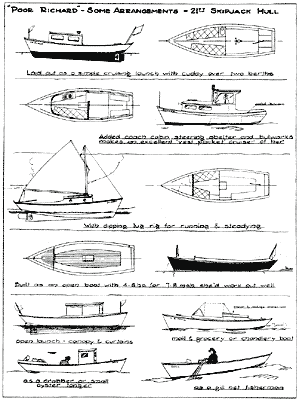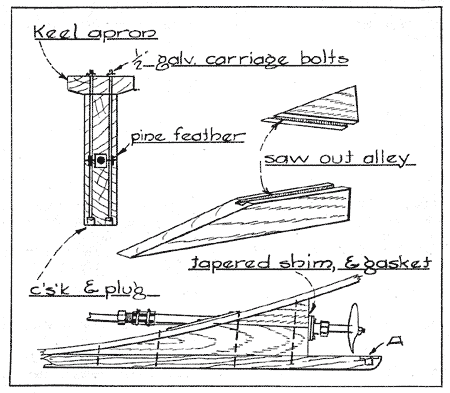Now any boat that Father Neptune has liked as a type for hundreds of years is bound to make a
good knockabout hull on which the
back-yard boatbuilder may add his
own private arrangement plan. To
show the versatility of the type, I've
drawn eight adaptations on the 21-foot hull for which the basic offsets
and constructions plans are given.

(click image above for larger view)
On the opening page you will see
three profiles and arrangements. A
word or two on each.
The upper arrangement is typically Chesapeake. It is in fact the exact
layout of a skipjack I found at
Speakers Yard on Spa Cteek, and
the lines of which I have modified
in this design. The cabin was of 1/2"
plywood with plain windows. This
cabin should more properly be called a cuddy because it is open at
the aft end, being closed by a canvas curtain. The motor of the original boat was a one-lung Lockwood-Ash or DuBrie, I believe, of about 3-3/4" x 4" bore and stroke, turning
a 3-blade 12" dia. x 14" pitch wheel
for a speed of about 7 mph—very
comfortable going on her length.
The motor was located exactly where
shown.
What might be done by a builder
who has sufficient skill to construct
a coach-type cabin, add a steering
shelter and bulwarks is next shown.
The hull is sufficiently weighty to
handle this Roamer top hamper provided it is kept light—say of half-inch cedar, with half-inch plywood
steering shelter crowned with quarter-inch canopy decking. Such a boat can handle a 4-cylinder Universal
Utility Four placed where shown,
although the trim will be lowered
forward to a degree. Such a motor
will give 10 mph, nearly, turning
a left-hand 13" dia. x 9" pitch wheel.
This is about the limit of speed.
More weight of engine or power
she cannot handle. She'll merely
squat and wallow.

If you like a dollop of rag aloft,
a short mast can be stepped over
beefed-up cabin carlins and a low
dipping-lug sail can be bent for
steadying and running off the wind.
The sail shown is moderate, and needs to be, for Poor Richard would
be too tender for a lofty-reaching rig.
The rag shown on Smorky is 4', 6"
on the luff, 6', 9" on the gaff,
11', 6" on the boom, about 10', 7" on the
leach, and the mast stands 10', 9"
with no bury. This will be enjoyable
with the wind abaft the beam, and
off the wind will kill much wild motion. The rudder in this case will
best be lengthened. A dipping lug
is a matter of balance, the halyard
tackle being delayed at the optimum point to flatten both peak,
and throat.
For a family boat, an old-time
"launch" arrangement is best. and
still good. This arrangement is labeled Jill. It gives the most room and
useful boat. A Universal 8 hp Fisherman, or any 4-8 hp one-cylinder
engine can be used for from 7-8 mph.
Two-cycle engines are preferred by
the writer for this type of boat, and
they are still made in the U.S. and
Canada, costing about $235 for a
new mill. Since such motors never
wear out, one can frequently find
them around boatyards for from $5
to $20, needing only a rebabbitted
bearing job to make them run again.
The open launch Jill could be
made into a rainy-weather boat by
the addition of stanchions, a standing canopy, and side curtains. See
profile.
Some locations afford good mail
and grocery routes, and a profile
showing a covered freight, mail and
motor compartment is shown. Not a
bad-looking little rig—with a spray-hood, too, for murky weather.
The crabber or oyster longer who
needs a new cheap boat will recognize his meat in the drawing of Ann.
The gill-netter or mackerel-chummer who wants to get to fishing on a
minimum outlay will sense in Gull
a fine beginning piece of equipment
and one that will quickly repay her
cost.
The writer has designed a number of fish boats and semicommercial hulls on this Chesapeake type
of bottom. They are in use in Alaska,
on the California coast and on the
Great Lakes, as well as on the Chesapeake. All are performing well under varied circumstances.

Now I am not going to tell you
how to drive every screw or how to
hold a hammer—that kind of space is
wasted because no two men have
access to the same materials. To
start building it will be necessary to lay down the lines full size, of
course. The lines are given to outside of planking, and you will have
to subtract from your body plan the
thickness of the planking you use.
I have specified ordinary clear 1"
x 6" boards for planking, but you
won't get this thickness commercially. What you will get will be between 3/4" and a strong 7/8" thickness. This will be all right.
The frames are best of 3/4" white
oak, but 1-1/4" spruce or tamarack
or mahogany will do just as well.
Since the boat will be built upside
down extend the frames to the floor
line, sawing off at the sheer line after
planking. Double cheekpieces are
glued and nailed to the frames with
galvanized shingle nails, leaving the
frame in one plane, is the best method. See gusset detail.
The transom will have to be "expanded"—don't make your transom
from the section in the body plan—it is not in the right plane. Go to
the raked stern for heights before
you go outboard for half breadths.
Watch the bevels closely.
The transom may be made up
feathered in the seams with a 1/4"
x 1/2" dado cut in each board using
a 1/4" x 7/8" white pine feather set
in casein glue, or the seams may be
cleated and caulked, as is the usual
practice with Chesapeake builders.
Transom planking is 1-1/8" yellow
pine, cypress or fir.
I show two types of keel construction. One is Chesapeake style, the
other the more universally known
apron type. The Chesapeakers run
the keel up into the hull two or
three inches, and then side-fasten
cheekpieces to form a rabbet. Thousands of boats have been built this
way. The rabbet cheeks are easily
beveled, and require only galvanized
screw or boat nail fastenings through
the cheek into the keel. Some money
is saved on long fastenings.
The disadvantage is that the
cheeks must usually be laid in canvas marine glue or paint to get a
tight job. Some amateurs can't do
this. Their tools get gummy and
the screws have a way of wadding
up the canvas.
The apron type of rabbeted plank
landing is a little harder to bevel,
uses more long fastenings. Through
bolts, 1/2" galvanized, will be required to draw the apron down to
the spring of the keel.
Now though the keel is of 4" stuff,
which means 3-3/4" nominal, if you
use the apron type of construction,
soak the apron in water for several
days to make it rubbery, then over
a horse or logs, or around stakes
driven into the ground, spring the
apron to twice normal bend and let
dry for a week or two. Otherwise
the 4" keel will not be able to keep
the correct, apron profile.

Here is a general list of scantling
sizes: -Planking, 13/16" white pine,
white cedar, cypress or mahogany..
Frames of 3/4" white oak spaced as
shown, or 1-1/4" spruce, tamarack, yellow pine or fir. Gussets for frames,
1/2" plywood set in casein glue and
screwed or nailed. Floor timbers
gained over keel and cheekpieces,
or fayed flat across the apron if that
type of construction is used.
The chine is of 1-1/8" x 2-1/4" oak.
This piece needs to be of oak to
hold fastenings, particularly if the
bottom planking is to be Chesapeake
style—that is, planked diagonally
from keel to chine, starting at about
15 degrees aft rake forward and
"fudging" a little until the final aft
pieces of plank are running diagonally across frames at about 45 degrees of angle.
This type of construction is a hallmark of the Chesapeaker. To obtain
the shape of the bottom forward, the
Bay men usually bolt on forefoot
badges of about 18" length of solid
timber and adz the shape in to fair
between the first thwartship plank
and the forefoot.
If thwartship planking is used, two
fore-and-aft battens, 1-1/8" x 2" of
fir, yellow pine or some similar wood,
must be gained into the frames to
provide bearing, one each side of keel.
The bottom may be planked fore-and-aft, without battens, using 1"
x 1-3/8" intercostal frames between
each main frame. These intercostals
must be used on the topside planking regardless of the type of bottom
planking. Use fore-and-aft planking
on the bottom only if you have access to a steam box, as there is much
twist to the garboard forward.
The sheer clamp will be 1-1/4" x
3" yellow pine or fir.
Stem is of oak, sided 3".
Stem knee is of oak, blended from
4" to 3" to fay on keel and stem.
Deck stringers along the coaming
edge, or plank-sheer edge, should be
i 1-1/8" x 2-1/2" yellow pine or fir—whatever is easiest to secure in your locality.
Deck beams for the cabin top and
the short foredeck may be 1-1/8" x
·2-1/2", best of oak.
Use all galvanized fastenings.
These are cheapest and last longest.
Under no circumstances use "coated" nails, or any bright or black
iron. If you use bronze, use bronze
all the way through. Don't mix metals in the fastenings of any boat, particularly if for salt-water use.
Don't put a converted auto engine
in Poor Richard. It probably will be
too heavy, and will "dollar" you to
death.
On the timber sizes given, and to
the lines as specified, anyone who
can saw and plane a board can build
this most acceptable hull. The fun
comes in putting in your own arrangement. Keep the weights balanced as possible, about the midsection, trim her aft with fuel and perishable stores, and she'll work out
extremely well.
WESTON FARMER

